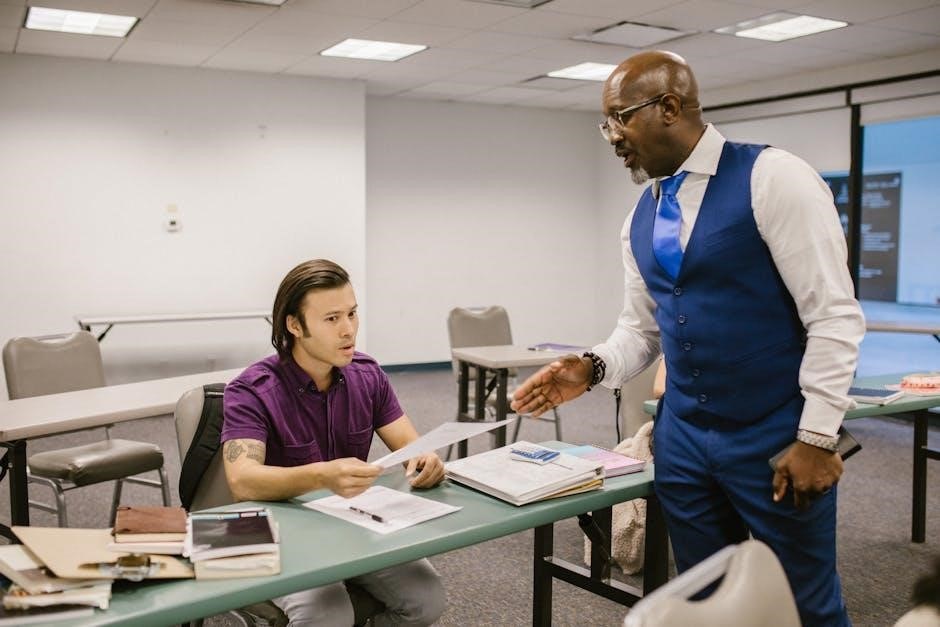In this heartfelt guide, David Brooks explores the art of deeply understanding others and fostering meaningful connections. His book offers practical insights into empathy, self-awareness, and emotional intelligence.
1.1 Importance of Understanding Others
Understanding others is a cornerstone of building meaningful relationships and fostering a harmonious society. In today’s world, where feelings of isolation and disconnection are prevalent, the ability to truly see and comprehend others becomes increasingly vital. David Brooks emphasizes that when we neglect this skill, we risk leaving people feeling unseen and misunderstood. By cultivating empathy and taking the time to appreciate diverse perspectives, we can bridge divides and create stronger, more compassionate communities. This skill is not only beneficial on a personal level but also has broader societal implications, helping to address issues like polarization and social fragmentation. Brooks’ insights highlight the transformative power of understanding others, encouraging readers to prioritize connection and empathy in their daily lives. This shift can lead to deeper, more fulfilling relationships and a more cohesive society overall.
David Brooks is a renowned American columnist, author, and commentator, widely recognized for his thought-provoking insights on society, culture, and human behavior. As a columnist for The New York Times, he has become a trusted voice in exploring complex social and moral issues. Brooks is also the author of several bestselling books, including The Road to Character and The Second Mountain, which delve into themes of personal growth, morality, and community; His writing often bridges the gap between journalism and philosophy, offering readers a deeper understanding of the human experience. In How to Know a Person, Brooks extends this tradition, focusing on the art of understanding others and fostering meaningful connections. His work is driven by a belief in the transformative power of empathy and the importance of nurturing relationships in an increasingly fragmented world.
1.3 Overview of the Book
How to Know a Person: The Art of Seeing Others Deeply and Being Deeply Seen by David Brooks is a practical guide to fostering meaningful connections in personal and professional life. The book emphasizes the importance of empathy, self-awareness, and emotional intelligence in understanding others. Brooks argues that in a world where relationships are often superficial, the ability to truly see and be seen by others is a rare and valuable skill. He provides insights into how to move beyond surface-level interactions and cultivate deeper, more fulfilling relationships. The book is structured to offer both theoretical understanding and actionable advice, making it accessible to readers seeking personal growth and improved social dynamics. Through real-life examples and philosophical reflections, Brooks encourages readers to embrace the transformative power of genuine human connection.

Core Concepts Explored
David Brooks explores empathy, self-awareness, and emotional intelligence as essential skills for deeply understanding others and fostering meaningful connections in personal and professional relationships.
2.1 The Art of Empathy
David Brooks emphasizes that empathy is a cornerstone of understanding others. He defines empathy as the ability to deeply see and understand another person’s perspective, moving beyond superficial interactions. Brooks argues that empathy is not just about feeling for others but also about truly comprehending their experiences and emotions. In How to Know a Person, he suggests that empathy requires active listening, curiosity, and a willingness to step into someone else’s shoes. Brooks highlights that in a world often dominated by judgment and quick assumptions, cultivating empathy allows us to build stronger, more meaningful relationships. He also notes that empathy is a skill that can be developed over time with practice and patience. By fostering empathy, individuals can create a ripple effect of understanding and compassion in their personal and professional lives, leading to deeper connections and a more harmonious society.
2.2 The Role of Self-Awareness
David Brooks underscores the importance of self-awareness in understanding others, asserting that it is the foundation of meaningful connections. He argues that without a deep understanding of oneself, it is challenging to truly see and appreciate others. Brooks suggests that self-awareness involves recognizing one’s own biases, emotions, and motivations, which in turn allows for a more authentic and empathetic approach to relationships. In How to Know a Person, he provides practical advice on cultivating self-awareness through introspection and self-reflection. Brooks emphasizes that this process is not about self-judgment but rather about gaining clarity on one’s own experiences and limitations. By becoming more aware of ourselves, we create space for others to be seen and understood. This dual focus on self and others is central to Brooks’ approach, enabling individuals to navigate relationships with greater depth and sincerity.
2.3 The Significance of Emotional Intelligence
David Brooks highlights emotional intelligence as a crucial component in understanding others. He argues that emotional intelligence is the bridge that connects self-awareness to empathy, enabling individuals to navigate complex social dynamics. Brooks emphasizes that emotional intelligence involves not only recognizing and managing one’s own emotions but also accurately perceiving and responding to the emotions of others. In How to Know a Person, he provides insights into how emotional intelligence fosters deeper connections and collaboration. Brooks suggests that cultivating emotional intelligence requires practice, including active listening, asking open-ended questions, and being present in interactions. He asserts that this skill is essential for building trust and resolving conflicts, both in personal and professional settings. By mastering emotional intelligence, individuals can create environments where others feel valued and understood, leading to more meaningful and fulfilling relationships. Brooks’ approach underscores the transformative power of emotional intelligence in fostering a more compassionate society.

Book Structure and Content
David Brooks’ book explores empathy, self-awareness, and emotional intelligence through well-structured chapters. The guide offers practical insights and is available in formats like PDF, audiobook, and hardcopy.
3.1 Chapter Overview
David Brooks’ How to Know a Person is structured to guide readers through the art of understanding others deeply. Each chapter focuses on a specific aspect of human connection, blending personal anecdotes with psychological insights. The book begins with an exploration of empathy, highlighting its importance in breaking down social barriers. Subsequent chapters delve into self-awareness, emotional intelligence, and the societal benefits of fostering deeper relationships. Brooks also shares practical strategies for applying these concepts in daily life, making the book both inspirational and actionable. The final chapters reflect on the broader implications of these connections, emphasizing their impact on personal growth and community building. The chapter structure ensures a comprehensive journey from individual understanding to collective transformation, offering readers a roadmap to more meaningful interactions.
3.2 Key Themes and Messages
At the heart of How to Know a Person is the belief that understanding others is a skill that can be cultivated. David Brooks emphasizes the importance of empathy, self-awareness, and emotional intelligence in fostering deeper connections. He argues that by truly seeing others, we not only enrich our personal relationships but also contribute to a more compassionate society. Brooks highlights the declining ability to connect deeply in modern life, linking it to isolation and division. He offers practical advice on how to move beyond superficial interactions, encouraging readers to embrace vulnerability and curiosity. The book also explores the transformative power of these connections, suggesting they can lead to personal growth, stronger communities, and even societal change. Brooks’ message is both hopeful and actionable, urging readers to prioritize understanding and empathy in their daily lives. His insights are timeless and universally relevant.
3.4 Structure and Presentation of Ideas
How to Know a Person is structured to guide readers through a journey of understanding and connection. Divided into clear chapters, the book builds incrementally, introducing key concepts and then applying them to real-life scenarios. Brooks uses storytelling and relatable examples to make his ideas accessible. Each chapter ends with actionable insights, reinforcing the book’s practical nature. The logical flow ensures readers can follow Brooks’ arguments effortlessly. His writing is engaging and concise, avoiding jargon while maintaining depth. The structure emphasizes the interconnectedness of empathy, self-awareness, and emotional intelligence. By blending personal anecdotes with broader societal observations, Brooks creates a narrative that is both personal and universal. This approach makes the book not only informative but also inspiring, encouraging readers to implement its lessons immediately. The clear structure and engaging presentation make How to Know a Person a compelling read for anyone seeking to deepen their connections with others.

Key Insights from the Book

How to Know a Person highlights the transformative power of empathy and connection. Brooks emphasizes that truly seeing others fosters deeper relationships and societal change, benefiting both individuals and communities.
4.1 The Skill of Seeing Others
David Brooks emphasizes that the ability to truly see others is a foundational skill for building meaningful connections. He argues that in a world where people often feel unseen, mastering this skill can lead to profound personal and societal transformations. Brooks suggests that seeing others deeply involves moving beyond surface-level interactions and instead engaging with their unique perspectives and experiences. This requires a combination of empathy, active listening, and a willingness to understand others without judgment. By cultivating this skill, individuals can foster deeper relationships, strengthen communities, and contribute to a more compassionate society. Brooks provides practical guidance on how to develop this ability, making it accessible to readers from all walks of life.
4.2 Fostering Deeper Connections
David Brooks highlights the importance of fostering deeper connections in our personal and professional lives. He argues that meaningful relationships are built on empathy, trust, and mutual understanding. Brooks suggests that by actively seeking to understand others’ stories and perspectives, we can create stronger bonds and more fulfilling interactions. This involves moving beyond superficial conversations and instead engaging in deeper, more vulnerable dialogue. He also emphasizes the role of emotional intelligence in navigating these connections, allowing us to respond to others with compassion and sensitivity. By fostering deeper connections, individuals can experience greater joy, support, and a sense of belonging. Brooks offers practical advice on how to cultivate these relationships, making his insights valuable for anyone looking to enrich their personal and professional lives.
4.3 Impact on Personal and National Scales
David Brooks emphasizes that the ability to truly know others has far-reaching implications, extending beyond personal relationships to societal levels. He argues that when individuals cultivate deeper connections, they foster empathy and understanding within their communities. This collective shift can lead to a more compassionate society, where people feel seen and valued. Brooks suggests that such societal changes can address issues like social isolation and polarization, promoting unity and cooperation. The book highlights the transformative power of these connections, illustrating how personal growth can lead to broader positive change. By encouraging readers to embrace these principles, Brooks aims to inspire a cultural movement toward greater empathy and understanding, ultimately benefiting both individuals and society as a whole. His vision underscores the idea that meaningful connections are the foundation of a healthier, more harmonious world.

Applications of the Book’s Principles
David Brooks’ principles can be applied to enhance personal relationships, improve workplace dynamics, and foster stronger communities by promoting empathy, effective communication, and deeper human connections.

5.1 Enhancing Personal Relationships
In How to Know a Person, David Brooks emphasizes the transformative power of empathy and self-awareness in fostering deeper personal connections. By actively listening and understanding others’ perspectives, individuals can build trust and intimacy. Brooks highlights the importance of moving beyond superficial interactions to create meaningful relationships rooted in mutual understanding. His insights encourage readers to embrace vulnerability and authenticity, which are essential for nurturing lasting bonds. The book also provides practical strategies for overcoming communication barriers and resolving conflicts, fostering a sense of unity and shared purpose. By applying these principles, individuals can strengthen their personal relationships, leading to greater fulfillment and emotional well-being.
5.2 Improving Workplace Dynamics
David Brooks’s insights in How to Know a Person extend to workplace environments, where understanding colleagues and fostering empathy can enhance collaboration and productivity. By encouraging a culture of deep connections, organizations can reduce misunderstandings and conflicts. Brooks suggests that leaders who prioritize emotional intelligence and actively seek to understand their team members create a more supportive and inclusive workplace. This approach not only boosts morale but also drives innovation, as diverse perspectives are valued and integrated. Additionally, the book offers practical advice on effective communication strategies, which can improve teamwork and decision-making processes. By applying these principles, workplaces can shift from merely transactional interactions to meaningful, purpose-driven relationships, ultimately benefiting both employees and the organization as a whole.
5.3 Building Stronger Communities
David Brooks emphasizes that fostering deeper connections, as outlined in How to Know a Person, can lead to stronger, more cohesive communities. By encouraging individuals to see and appreciate one another’s unique perspectives, societal bonds are strengthened. Brooks highlights the importance of moving beyond superficial interactions to create meaningful relationships that transcend differences. This shift can reduce social isolation and foster a sense of belonging, which is essential for thriving communities. The book suggests that when people feel seen and understood, they are more likely to contribute positively to their communities. By applying these principles, neighborhoods and societies can become more compassionate and collaborative, leading to collective growth and well-being. Brooks’ insights provide a roadmap for building a culture of empathy and connection that benefits everyone; This approach not only enriches individual lives but also strengthens the fabric of society as a whole.

The Broader Implications
David Brooks highlights how fostering deeper connections can address societal challenges like isolation and division. His insights promote cultural shifts toward empathy, creating a more compassionate and unified society.
6.1 Addressing Social Isolation
In How to Know a Person, David Brooks addresses the growing issue of social isolation by emphasizing the importance of meaningful human connections. He argues that our declining ability to truly see and understand others has led to widespread feelings of loneliness and disconnection. Brooks suggests that fostering deeper relationships through empathy and self-awareness can help bridge these gaps. By encouraging individuals to engage more profoundly with others, the book offers a pathway to combating isolation. This approach not only benefits personal well-being but also contributes to healing societal divisions. Brooks’ insights highlight the transformative power of genuine human interaction in creating a more compassionate and connected world. His practical guide provides tools to reinvigorate relationships and rebuild a sense of community, offering hope for a more unified society.
6.2 Promoting Cultural Shifts
David Brooks’ book, How to Know a Person, calls for a cultural shift by redefining how we interact with others. He argues that fostering deeper connections and embracing empathy can lead to societal transformation. Brooks emphasizes that understanding others on a profound level is not just a personal skill but a collective responsibility. By encouraging individuals to move beyond superficial interactions, he advocates for a culture that values meaningful relationships and mutual understanding. This shift, he believes, can combat polarization and divisiveness, fostering a more compassionate and unified society. Brooks’ vision extends beyond individual growth, aiming to create a cultural movement that prioritizes human connection and empathy. His practical guide serves as a roadmap for this change, inspiring readers to be agents of positive transformation in their communities and beyond.
6.3 Societal Benefits of Deep Connections
David Brooks’ insights in How to Know a Person highlight the profound societal benefits of fostering deep connections. By prioritizing empathy and understanding, individuals can help reduce polarization and social isolation, creating more cohesive communities. Brooks argues that when people feel seen and valued, they are more likely to engage positively with others, fostering trust and collaboration. This, in turn, strengthens societal structures and promotes collective well-being. The book suggests that deep connections can address systemic issues like loneliness and disconnection, fostering a more compassionate and unified society. Brooks’ vision extends to the broader societal level, emphasizing that meaningful relationships are the foundation of a healthy and thriving culture. His work encourages readers to recognize the transformative power of human connection, not just for personal growth but for the betterment of society as a whole.

Resources and References
How to Know a Person by David Brooks is available as a PDF, Audiobook, and Hardcover. It can be found on Amazon, Barnes & Noble, and other online retailers.
7.1 Where to Find the Book
How to Know a Person by David Brooks is widely available across various platforms. Readers can find the book in PDF format on Amazon, Barnes & Noble, and Google Books. Additionally, it can be purchased as a Hardcover or Audiobook from major retailers like Book Depository and IndieBound. For those preferring digital copies, the book is accessible through Kindle, Kobo, and Apple Books. Many libraries also offer it for borrowing. Furthermore, supplementary materials and reviews can be found on Goodreads and the author’s official website.
7.2 Available Formats
How to Know a Person by David Brooks is available in multiple formats to cater to different preferences. The book can be purchased as a Hardcover or Paperback, offering a tangible reading experience. For digital enthusiasts, it is accessible as an e-book on platforms like Kindle, Kobo, and Apple Books. Additionally, an Audiobook version is available on Audible and other audiobook platforms, perfect for those who prefer listening on the go. A PDF version can also be downloaded from various online retailers, making it easy to read on devices like tablets and smartphones. This variety ensures that readers can engage with Brook’s insights in the format that suits them best, whether they enjoy physical copies, digital convenience, or immersive audio experiences.
7.3 Supplementary Materials
For readers seeking to deepen their understanding of How to Know a Person, various supplementary materials are available. These include study guides and discussion questions that facilitate group conversations or personal reflection. Additionally, author interviews and podcast discussions provide further insights into Brook’s ideas. Some platforms offer summaries and analysis of key chapters, helping readers grasp complex concepts. Furthermore, reflection exercises and action plans can be found online, enabling readers to apply the book’s principles in their daily lives. These resources are often accessible through the publisher’s website or online communities dedicated to the book. They serve as valuable companions for those looking to engage more deeply with Brook’s philosophy and integrate his teachings into their personal and professional lives.
How to Know a Person by David Brooks offers a transformative guide to building deeper connections. By embracing empathy and self-awareness, readers can foster meaningful relationships and create a more compassionate society. Start your journey today!
8.1 Summary of Key Points

How to Know a Person by David Brooks emphasizes the importance of empathy, self-awareness, and emotional intelligence in fostering deeper connections. Brooks argues that these skills are essential for understanding others and building meaningful relationships. He highlights the transformative power of truly seeing and being seen, both on a personal and societal level. The book encourages readers to move beyond superficial interactions and cultivate authenticity. By doing so, individuals can create stronger bonds at home, work, and within their communities. Brooks also underscores the broader implications of these connections, suggesting they can lead to a more compassionate and harmonious society. Ultimately, the book serves as a practical guide for anyone seeking to enrich their relationships and contribute to a deeper sense of human connection in the world.
8.2 Encouragement to Engage
Embracing the principles of How to Know a Person can lead to profound personal growth and stronger, more meaningful relationships. David Brooks’ insights encourage readers to step beyond surface-level interactions and embrace the richness of genuine human connection. This book is not just a theoretical guide; it offers practical steps to apply its teachings in daily life. By engaging with these ideas, readers can cultivate empathy, deepen their understanding of others, and foster a sense of community. Brooks’ message is both inspiring and challenging, urging us to reflect on how we interact with the world around us. Start small, but stay committed—every effort to see and be seen can lead to more authentic and fulfilling relationships. Ultimately, this book invites us to envision a world where deeper connections create a more compassionate and harmonious society.